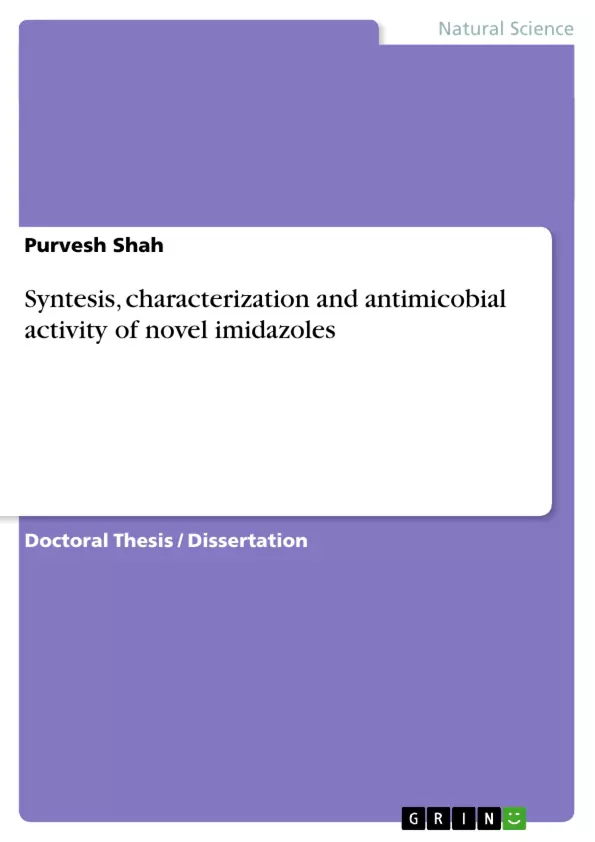The condensation reaction of 4-benzylidene-2-phenyloxazol-5-one (2) with 2-amino-4-substitued benzothiazoles (3a-f) was yielded a series of 4-benzylidene-1-(substitued-2-
benzothiazolyl)-2-phenyl-1H-imidazol-5(4H)-one (4a-f). The 4-benzylidene-2-phenyloxazol-5-one (2) has been prepared from cyclo condensation reaction between N-benzoyl glycine(1) with benzaldehyde. The novel prepared compounds were characterized by IR, 1H-NMR,13C-NMR and Mass spectral data. All the prepared compounds were screened for their antibacterial and antifungal activities.
Inhaltsverzeichnis (Table of Contents)
- INTRODUCTION
- REVIEW OF LITERATURE
- OBJECTIVES
- MATERIALS AND METHODS
- RESULT AND DISCUSSIONS
- SUMMARY AND CONCLUSIONS
- REFRENCES
Zielsetzung und Themenschwerpunkte (Objectives and Key Themes)
This thesis aims to investigate the synthesis, characterization, and antimicrobial activity of novel imidazole compounds. It explores the potential of these compounds as potential therapeutic agents against various bacterial infections.
- Synthesis of novel imidazole derivatives
- Characterization of the synthesized compounds
- Evaluation of antimicrobial activity against various bacterial strains
- Investigation of the structure-activity relationship of the imidazole compounds
- Potential applications of the synthesized imidazoles as therapeutic agents
Zusammenfassung der Kapitel (Chapter Summaries)
- INTRODUCTION: This chapter provides a general overview of the research topic, including the significance of antimicrobial drug discovery and the role of imidazoles in this area. It also introduces the specific objectives of the thesis.
- REVIEW OF LITERATURE: This chapter presents a comprehensive review of the existing literature on imidazole compounds, including their synthesis, characterization, and antimicrobial activity. It discusses the various strategies used for the development of novel imidazoles and the challenges faced in this area.
- OBJECTIVES: This chapter outlines the specific research objectives of the thesis, highlighting the key questions that the study aims to address.
- MATERIALS AND METHODS: This chapter describes the materials and methods used in the research, including the synthesis procedures, characterization techniques, and antimicrobial activity assays. It also details the specific bacterial strains used for testing the antimicrobial activity.
- RESULT AND DISCUSSIONS: This chapter presents the experimental results and a detailed discussion of their significance. It analyzes the structure-activity relationship of the synthesized imidazole compounds and explores the potential mechanisms of their antimicrobial activity.
Schlüsselwörter (Keywords)
The research focuses on the synthesis, characterization, and antimicrobial activity of novel imidazole compounds. Key themes include drug discovery, antimicrobial activity, structure-activity relationship, and potential therapeutic applications. This research delves into the development of potential antimicrobial agents to combat bacterial infections.
- Quote paper
- Purvesh Shah (Author), 2013, Syntesis, characterization and antimicobial activity of novel imidazoles, Munich, GRIN Verlag, https://www.grin.com/document/270251



